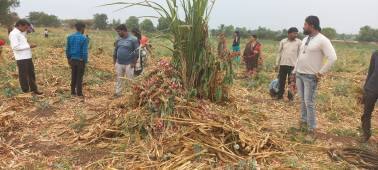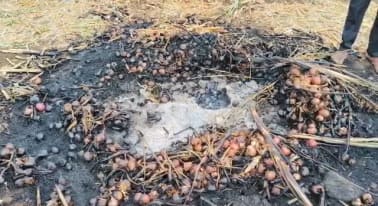



Sunil Bargude, 44, a farmer from Naitale village of Nashik district in Maharashtra, destroyed his onion crop in the field. The cost of pulling out the onion bulbs from the plot and ferrying them to the nearest market would have been higher than the price he would have earned from selling his crop.
“I had already invested about Rs 1.25 lakh in sowing the crop. I would have hardly gotten Rs 25,000 after selling it. The cost of labour to pull out my crop and the cost of transportation to sell it came out to be higher than that. I saw no option but to bury the crop in the land itself,” Bargude said.
Onion prices at India’s largest onion market, Nashik's Lasalgaon Agricultural Produce Market Committee (APMC), have dropped almost 70 percent in the past two months, says agriculture expert Devinder Sharma. Onion farmers in Maharashtra have been compelled to sell their crops at Re 1 to Rs 2 per kilogram. Potato farmers in Uttar Pradesh, Punjab, and Haryana have met the same fate with prices dropping below Rs 4 per kilogram, far below their input costs.
Onion farmers have no option but to sell their produce at the market rate because of the low shelf-life of the late Kharif onions.
Bargude, who has a family of 10, is worried about the repayment of the loan he had taken expecting a bumper crop.
“I have a loan of about Rs 17 lakh pending. I had taken it to plough my lands, build a small home and invest in farming equipment, anticipating a good harvest. I will not be able to re-pay this loan or its interest,” he says.
“This will make the interests rise too. From 7.4 per cent this year to about 10 per cent next year. I don’t know what to do, one year of poor finances will haunt us for the next decade,” Bargude adds.
On March 6, the day of Holika Dahan, Several farmers in Nashik set their crops of onion on fire, to draw attention to their plight. Bonfires are traditionally lit in Maharashtra and elsewhere in India on the day.
 Farmers make a bonfire of their onion crops in Maharashtra's Nashik amid falling crop prices on March 7
Farmers make a bonfire of their onion crops in Maharashtra's Nashik amid falling crop prices on March 7
 Burned onion crop after farmers set it on fire in Nashik, Maharashtra
Burned onion crop after farmers set it on fire in Nashik, Maharashtra
Impact on farmers
Seeking relief, a group of farmers from Ahmednagar in Maharashtra have sent onion by post to Prime Minister Narendra Modi and demanded the lifting of a ban on the export of the crop, PTI reported, quoting farmers belonging to Shetkari Sanghatana and Shetkari Vikas Mandal, farmers’ unions active in the state.
Meanwhile, the price of potatoes in northern states has nosedived too. Panchkula district farmers president Narinder Singh says the price has fallen to Rs 4 per kilogram from Rs 15 earlier. “Our input cost alone is at least Rs 7 per kilogram. How can we break even in this,” he asks.
Table varieties of potato, which were priced between Rs 1,400 to Rs 1,500 per quintal last season, are fetching around Rs 350- Rs 400 a quintal this time while the premium varieties, which fetched Rs 1,800 a quintal last season, are being sold for around Rs 550 a quintal.
Sambhal in Uttar Pradesh is a hub of potato growers. Bharatiya Kisan Union (Asli) president of western Uttar Pradesh Sanjeev Gandhi says long lines of tractor trolleys at cold storages have been formed to save the crop. Each farmer is having to wait up to 24 hours.
“Potatoes at this time are being sold at Rs 3.25 to Rs 3.5 per kilogram in UP. Our input cost itself is more than Rs 8 per kilogram. Farmers are thus resolving to store them so they may get a better price later, but the condition has become so dire that long queues are forming everywhere,” he says.
The cold storages, he said, are asking for money in advance this time instead of waiting until the sale of potatoes. “The cold storages suspect that the prices may fall further and farmers may leave the produces in storages itself. They are thus seeking advance rents which we don’t have (money to pay for). The rents for storage have also risen in the state,” says Gandhi.
What has the government done?
The centre on March 7, directed the National Agricultural Cooperative Marketing Federation of India Limited (NAFED) and National Consumers Cooperative Federation of India Limited (NCCF) to immediately intervene in the market for the purchase of Red Onion (Kharif) for simultaneous dispatch and sale to the consumption centres across the country, in the wake of reports of their falling prices.
The Gujarat Government, on March 7, announced a Rs 330 crore assistance package for onion and potato farmers in the state who have been struggling to sell their produce because of a glut in the market.
The assistance, announced in the Gujarat Assembly, includes a transport subsidy to farmers who were willing to sell their produce outside the state or prefer to export them.
After farmers on February 27 forced the suspension of trading at Lasalgaon, in Maharashtra’s Nashik district, following the crash in prices, the Maharashtra government intervened, promising subsidies to crops being sold.
The National Agricultural Cooperative Marketing Federation (NAFED) later issued a statement promising to increase procurement in Nashik.
“NAFED has opened limited centres in the district, which will likely go up. The Centre’s move will provide stability to the onion market. NAFED has also planned to procure Rabi onions from April for buffer stocking. The major procurement takes place in the Nashik district. Farmers are requested to bring their good quality and dried stock to the procurement centres to avail of better rates at these centres. The payment will be made online,” a press release said.
No intervention has been made by the governments of Haryana, Punjab or Uttar Pradesh yet.
What is a market Intervention Scheme? How can it help?
The government implements a Market Intervention Scheme (MIS) for the procurement of agricultural and horticultural commodities that are perishable and are not covered under the Price Support Scheme (PSS). The objective is to protect the growers of these commodities in the event of a bumper crop during the peak arrival period.
While the government’s Market Intervention Scheme could have saved the day, the budget for FY 2024 has allocated only about Rs 1 lakh to it.
Agriculture expert Devinder Sharma, terming this a potential ‘bloodbath’ for the farmers, says government intervention is necessary to avert this.
“The government needs to fix a base price and not allow any purchase to happen below that rate. It should start the procurement of onions and make cold storages to help both the farmers and the consumers,” he says.
“The Market Intervention Scheme needs to be brought into action as soon as possible. This will help not just the farmers from the dip but protect the consumers when prices rise. The livelihood of millions stands affected right now,” Sharma adds.
Dr Laxmi Joshi, a fellow at the National Council of Applied Economic Research (NCAER) with research interests in agriculture and rural development, says: “The scheme is important to intervene in the market to protect the growers of their commodities from making distress sale in the event of a bumper crop during the peak arrival period when the prices tend to fall below economic levels and cost of production.”
According to budget documents, while the scheme had been allocated an amount of Rs 1,500 crore in the budget estimates for FY 2022-23, the amount dropped to Rs 1 lakh in the budget for FY 2023-24. The scheme has been used extensively in the past. While budget 2021-22 had allocated an amount of Rs 1,500 crore, an amount of Rs 2,288 crore was actually used.
Discover the latest Business News, Sensex, and Nifty updates. Obtain Personal Finance insights, tax queries, and expert opinions on Moneycontrol or download the Moneycontrol App to stay updated!
Find the best of Al News in one place, specially curated for you every weekend.
Stay on top of the latest tech trends and biggest startup news.